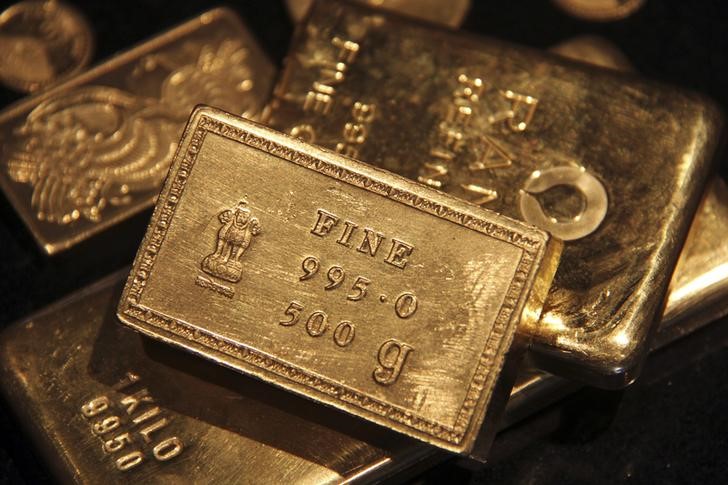By Barani Krishnan
Investing.com - Another Monday, another nightmare for gold bulls. Thanksgiving might be in the air but to the safe-haven crowd banking on gold, it feels like Halloween never ended.
Gold plummeted to four-month lows beneath $1,835 an ounce as renewed risk appetite across markets and a stronger dollar redirected money from the yellow metal into stocks and other risk assets like oil.
Gold for December delivery settled down $34.60, or 1.8% at $1,837.80 an ounce on New York's Comex. The session low was $1,828.25 — a bottom not seen since July 17 when the front-month U.S. gold futures contract sunk to $1,821.
The collapse in gold futures was spectacular particularly because it hit a bottom even lower than the spot price of gold, which reflects real-time trades in bullion. Spot gold’s low for the day was just $1,831.08.
Wall Street’s Dow was up 0.8% while the Dollar Index edged 0.2% higher.
The trigger for gold’s collapse was eerily similar to two Mondays ago, although the actual loss — or shock value — was more muted this time: Once again, progress in a Covid-19 vaccine dealt a knockout blow to gold bulls, this time coming from AstraZeneca (NASDAQ:AZN).
The British-Swedish drug company said clinical trials showed its Covid-19 vaccine was 70% effective in protecting against the virus and could reach 90% on a second dose. It could also be stored in an ordinary refrigerator and likely to be much cheaper than a rival vaccine from Pfizer (NYSE:PFE), which announced a 95% efficacy-rate but super-freeze storage conditions two Mondays ago.
The Pfizer announcement sent gold down 5% on Nov. 9. The yellow metal also lost 3% over two subsequent days after progress reported in another Covid-19 vaccine by Moderna (NASDAQ:MRNA) on Nov. 16.
“Gold isn't particularly fond of all this vaccine news and is once again finding itself trading lower and within a whisker of major support,” said Craig Erlam, analyst at OANDA in New York. “The next support below here lies around $1,800 and we could see it tested very quickly.”
Gold chartist Guillermo Alcala concurred in a blog posted on FX Live, saying:
“On the downside, below intra-day low at $1,830, next areas of interest would be $1,795 (mid-July lows) and $1,760, the 50% Fibonacci Retracement of the March – July rally.”
The AstraZeneca news aside, Regeneron (NASDAQ:REGN)'s coronavirus antibody cocktail, used by President Donald Trump when he was hospitalized with Covid-19 last month, has been granted emergency use authorization by the Food and Drug Administration.
What’s more, the chief scientific adviser to "Operation Warp Speed" — the U.S. Covid-19 vaccine program — said at the weekend that Pfizer and its German partner BioNTech will likely be approved by the U.S. Food & Drug Administration to begin immunizing Americans against the virus by Dec. 11.
Combined it was a cocktail of vaccines and therapeutics enough to tranquilize a gold market struggling to hold in the $1,800-$1,900 region since losing its $2,000-plus record highs from August. Logically, gold can rally for two reasons — fear of more Covid-19 lockdowns that can cripple the economy or runaway stimulus spending to fix the pandemic-hit economy.
With more progress in vaccines, the chance of shutdowns look more remote. Another Covid-19 stimulus — similar to the one in March that helped form the base for $2,000 gold — also appears to be a pie-in-the-sky, with Senate Republicans and the outgoing Trump administration barely assisting Democrats in the House and the incoming Biden government to get a new bipartisan fiscal package going.
For context, Democrats, who control the House, reached agreement in March with the Trump administration and Senate Republicans to pass the Coronavirus Aid, Relief and Economic Security (CARES) stimulus. That package dispensed roughly $3 trillion as paycheck protection for workers, loans and grants for businesses and other personal aid for qualifying citizens and residents.
Since then, the two sides have been locked in a stalemate on a successive relief plan to CARES. The dispute has basically been over the size of the next stimulus as thousands of Americans, particularly those in the airlines sector, risked losing their jobs without further aid.
“I'm still not convinced we've seen the end of gold's ascent, with plenty more stimulus still on the horizon,” said OANDA’s Erlam. “The Fed and European Central Bank are likely to unleash more in December in response to the latest Covid surge and, in the case of the former, delayed agreement on fiscal support. That should also come, all of which could give gold its spark back.”
